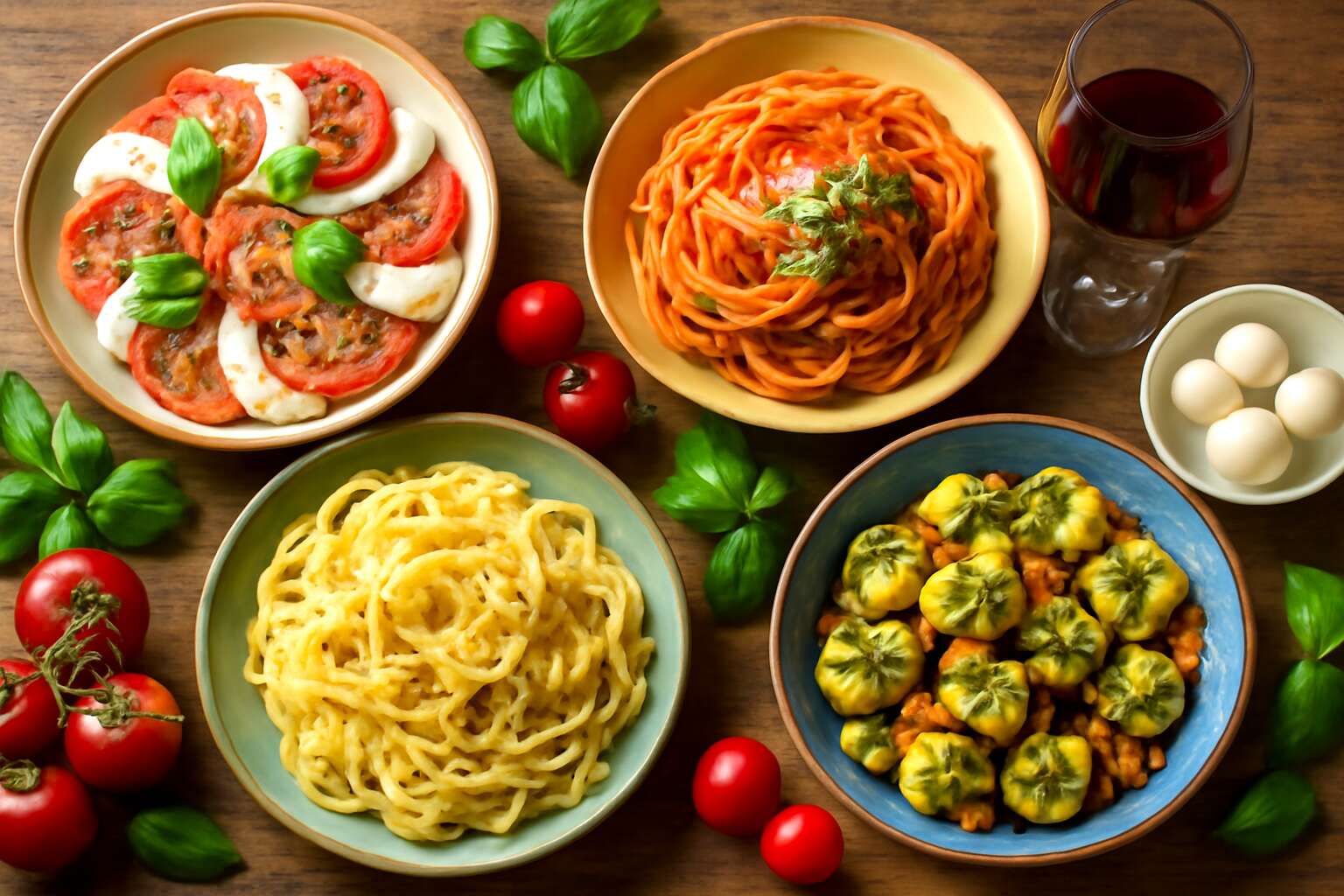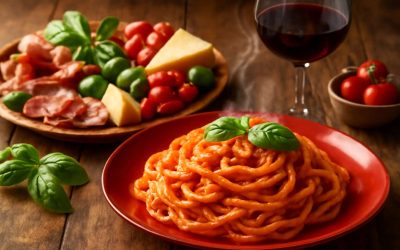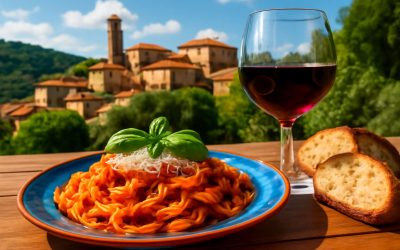Classic Italian Dishes That Never Fail
Authentic Pasta Recipes
In a world where culinary traditions intertwine like the threads of a finely woven tapestry, few cuisines evoke the same visceral warmth as Italy’s. The allure of authentic pasta recipes lies not merely in their ingredients but in the artistry behind each dish—an unspoken dialogue between chef and tradition. When seeking ideas for Italian food that resonate with both simplicity and sophistication, classic dishes stand as unwavering pillars of cultural expression.
Imagine a plate of velvety Risotto alla Milanese, its saffron-infused grains whispering stories of golden fields, or the robust flavors of Spaghetti Carbonara, where pancetta and Pecorino create a symphony of textures. These timeless recipes exemplify the depth of Italian culinary philosophy—each bite a testament to generations of passionate craftsmanship.
For those exploring ideas for Italian food, embracing these authentic pasta recipes offers a glimpse into Italy’s culinary soul. Whether crafted with fresh, local ingredients or passed down through family recipes, these dishes embody the essence of Italy’s gastronomic heritage—an invitation to indulge and explore endlessly.
Traditional Risotto Variations
Few culinary pursuits rival the timeless charm of classic Italian dishes, especially when it comes to risotto. This humble yet sophisticated staple embodies Italy’s dedication to marrying simplicity with depth of flavor. Interestingly, over 80% of Italian households have a signature risotto recipe, proving its place at the heart of culinary tradition.
Among the most beloved ideas for Italian food are variations of risotto that elevate the humble grain into a feast for the senses. Whether it’s the vibrant saffron hue of Risotto alla Milanese or the earthy richness of mushroom risotto, each version tells a story. For an extra layer of indulgence, incorporating ingredients like fresh seafood or seasonal vegetables can transform the dish into a masterpiece.
Here are a few trusted ideas for Italian food that never fail:
- Risotto al Tartufo – topped with fragrant truffle shavings for an unmistakably luxurious touch.
- Risotto Verde – infused with spinach or basil, providing a fresh, herbal twist.
- Seafood Risotto – bursting with prawns, calamari, and a splash of white wine for oceanic allure.
Each of these ideas for Italian food demonstrates that in Italy, even a simple risotto can be an elegant canvas—an invitation to indulge in tradition, innovation, and the art of slow culinary craftsmanship. After all, the beauty of Italian cuisine lies in its capacity to adapt and inspire, dish after dish.
Popular Italian Soups and Stews
In the realm of Italian cuisine, few culinary pursuits evoke the soul quite like their hearty soups and stews. These dishes, rich in tradition and bursting with flavor, serve as the comforting heartbeat of Italy’s culinary tapestry. As the seasons shift, so do the ingredients—each bowl a testament to Italy’s mastery of turning humble produce into masterpieces. When exploring ideas for Italian food, these classic soups provide endless inspiration, blending rustic charm with sophisticated depth.
Among the most beloved are the timeless Minestrone and Zuppa Toscana. Minestrone, a vibrant mosaic of seasonal vegetables, beans, and pasta, embodies the Italian philosophy of simplicity and freshness. Meanwhile, Zuppa Toscana, with its smoky sausage, creamy broth, and hearty potatoes, offers a warming embrace that feels like a culinary hug. For those seeking a touch of elegance, a fragrant Minestrone alla Genovese with basil pesto elevates the humble soup to a symphonic delight.
Here are a few ideas for Italian food that beautifully showcase this genre:
- Velvety Italian Lentil Soup—a nutritious, rustic delight that warms the soul.
- Spicy Cioppino—a tomato-based seafood stew that captures Italy’s maritime spirit.
Each of these ideas for Italian food underscores the artistry of slow, deliberate cooking. Italian soups and stews are more than mere starters; they are the poetic expression of Italy’s love affair with flavor, tradition, and the communal joy of sharing a warm bowl. In every spoonful, there lies an echo of Italy’s passionate culinary heritage, waiting to be rediscovered and cherished anew.
Regional Italian Cuisine Ideas
Northern Italy Specialties
In the lush, rolling landscapes of Northern Italy, culinary traditions unfold like a carefully woven tapestry of flavors and history. This region boasts an array of ideas for Italian food that evoke the very essence of alpine charm and fertile plains. From the fragrant, butter-laden polenta of the Veneto to the delicate, herb-infused dishes of Piedmont, each bite tells a story rooted in centuries of artistry and local produce.
One of the most enchanting aspects of Northern Italian cuisine is its mastery of regional ingredients. Think rich cheeses like Gorgonzola, hearty game meats, and fresh truffles that seem to have been plucked from the earth itself. For those seeking ideas for Italian food that embody rustic sophistication, exploring specialties such as bagna cauda—a warm garlic and anchovy dip—or ossobuco, slow-braised veal shanks, is essential. These dishes showcase the region’s penchant for bold flavors and comforting textures.
Here are some quintessential Northern Italy specialties that define its culinary allure:
- Polenta taragna with mountain cheeses
- Truffle-infused risottos from Piedmont
- Stuffed pasta like agnolotti and tortellini
Each idea for Italian food from the North offers a glimpse into a world where tradition and innovation meld seamlessly, creating a gastronomic experience as vast and varied as the landscapes themselves.
Central Italy Classics
Central Italy’s culinary heritage is a treasure trove of ideas for Italian food that balance rustic charm with sophisticated complexity. Unlike the hearty, cheese-laden dishes of the North, this region offers a lighter, more aromatic approach—think fresh herbs, vibrant vegetables, and simple preparations that let quality ingredients shine. It’s where tradition meets innovation in the most delightful ways.
One of the standout classics is the region’s renowned **lamb and vegetable stews**, simmered slowly to develop deep, soulful flavors. The countryside also produces an abundance of *artichokes, fennel*, and *olives*, which form the backbone of many regional dishes. For those craving ideas for Italian food that are both hearty and refined, dishes like *cacciatora*—a rustic chicken or rabbit stew with tomatoes and herbs—or *pici* pasta tossed in aromatic sauces are perfect choices.
In addition to these, the region is famous for its **extra-virgin olive oils** and **artisanal cheeses** that elevate any dish. The following list highlights some quintessential Central Italy specialties:
- Wild boar ragù served over fresh pici pasta
- Artichoke and pecorino quiche
- Hearty bean and vegetable minestrone
Ideas for Italian food from Central Italy celebrate the harmony of robust flavors and delicate nuances—an ode to a landscape where tradition, innovation, and a dash of joie de vivre come together on every plate.
Southern Italian Flavors
Southern Italy’s culinary landscape is a symphony of sun-drenched flavors, where each dish whispers tales of ancient tradition and vibrant zest. It is a region that beckons with the promise of bold, fiery spices and fresh, locally-sourced ingredients that dance on the palate. The idea for Italian food from the south often revolves around the bounty of the Mediterranean—ripe tomatoes, fragrant basil, and the unmistakable tang of citrus—woven into dishes that are as lively as the coastlines they hail from.
It’s impossible to overlook the region’s love affair with seafood—think tender calamari, briny anchovies, and succulent shrimp—prepared simply to emphasize their natural splendor. For those seeking ideas for Italian food that evoke warmth and passion, dishes like *orecchiette* with broccoli rabe or *caponata*—a sweet and sour eggplant relish—are quintessential. These recipes encapsulate the spirit of southern Italy, where every bite is a celebration of life, sun, and sea.
- Spicy sausage and roasted pepper pasta
- Sweet and savory caponata with fresh bread
- Crispy arancini filled with ragù
Ideas for Italian food from the south often embrace the concept of rustic elegance—an artful balance of humble ingredients elevated through tradition and passion. It’s a cuisine that invites you to savor each moment, each flavor, with the same fervor that defines the southern spirit itself!
Modern Twists on Traditional Recipes
Vegetarian and Vegan Ideas
In a world where culinary boundaries are constantly expanding, exploring modern twists on traditional Italian recipes unveils a symphony of innovation and authenticity. Imagine a velvety vegan eggplant parmigiana, reimagined with cashew cheese that melts like a dream, or a zesty, vegetarian lasagna layered with seasonal vegetables and fragrant herbs. These ideas for Italian food breathe new life into beloved classics, transforming comfort food into vibrant, health-conscious masterpieces.
For those embracing plant-based lifestyles, the possibilities are as boundless as the Tuscan skies. Think beyond the usual—try a cauliflower-based gnocchi or a rich mushroom ragu served over gluten-free polenta. Here are some inspiring ideas for Italian food that will captivate even the most discerning palate:
- Vegan Risotto infused with saffron and roasted vegetables
- Stuffed zucchini boats with tomato, basil, and plant-based cheese
- Hearty vegetable minestrone with a splash of truffle oil
These inventive ideas for Italian food showcase how tradition can be seamlessly woven into modern, plant-powered cuisine—delighting the senses while honoring Italy’s culinary soul!
Seafood-Inspired Variations
Seafood lovers, rejoice! Italian cuisine isn’t just about pasta and pizza; it’s a treasure trove of seafood-inspired variations that elevate traditional recipes to new culinary heights. Imagine a delicate linguine tossed with fresh clams, garlic, and a splash of white wine, or a rich seafood risotto bursting with the flavors of the ocean. These ideas for Italian food showcase how seafood can be seamlessly integrated into beloved classics, transforming them into sophisticated dishes that impress even the most discerning palate.
For a modern twist, consider trying:
- Grilled octopus served with a zesty lemon herb sauce
- Seafood-stuffed calamari with a hint of saffron
- Seafood pasta with a spicy tomato and basil sauce
These innovative ideas for Italian food not only celebrate Italy’s rich maritime heritage but also demonstrate how seafood can be used to craft vibrant, health-conscious dishes. Whether it’s a simple seafood salad or an elaborate seafood lasagna, the possibilities are as vast as the Mediterranean Sea itself—proving once again that Italian cuisine is a playground for seafood enthusiasts seeking creative culinary ideas for Italian food.
Healthy Italian Meals
In the shadowy corners of Italy’s culinary landscape, a whisper of innovation breathes new life into age-old recipes. Modern twists on traditional dishes reveal a daring approach to healthy Italian meals, where vibrant ingredients meet inventive techniques. These ideas for Italian food are not merely about preservation but about transformation—an elegant dance between heritage and modernity. Imagine a velvety zucchini lasagna, layered with a cashew béchamel, offering a plant-based reinterpretation that delights the senses without guilt.
For the adventurous, a curated list of ideas for Italian food can ignite inspiration:
- Cauliflower gnocchi with sage and lemon zest
- Sweet potato ravioli served with a drizzle of truffle oil
- Chickpea-based pasta with roasted vegetables and a basil-infused olive oil
These creations embrace the core of Italian culinary artistry while elevating it into a realm of health-conscious elegance. Each dish embodies the mysterious allure of Italy’s rich food traditions, woven seamlessly with contemporary vitality, making ideas for Italian food both timeless and refreshingly novel.
Desserts That Showcase Italian Sweetness
Iconic Italian Desserts
Few culinary traditions evoke such a sense of timeless elegance as Italian desserts; they are the sweet whispers of a culture that values both art and tradition. When exploring ideas for Italian food, one cannot overlook these iconic confections that have captivated hearts for centuries. Each bite offers a glimpse into Italy’s rich history, where sweetness is intertwined with history and regional identity.
Italian desserts often balance simplicity with decadence, creating a symphony of flavors that linger. Classics like Tiramisu tantalize with layers of mascarpone and espresso, while Cannoli burst with ricotta and candied fruit. These desserts are more than just endnotes—they are the crescendo of any authentic Italian meal. For those seeking a more rustic charm, Panna Cotta presents a delicate, creamy delight that perfectly concludes a feast.
Among the many ideas for Italian food, exploring the diversity of Italian desserts reveals a treasure trove of flavors and textures. From the velvety richness of Zabaglione to the crispy, honey-glazed Biscotti, each offers a unique experience. These indulgent creations are the epitome of Italian sweetness, a testament to a culture that celebrates life through its culinary artistry.
Regional Sweet Treats
Within Italy’s shadowed landscapes lie regional sweet treats that whisper secrets of centuries past, each one a haunting testament to local traditions and flavors. These desserts, more than mere indulgences, are gateways into the soul of Italy’s diverse culinary tapestry. From the velvet-rich Zabaglione of Tuscany to the honey-drizzled Sicilian Canestrelli, each idea for Italian food reveals a different facet of a culture obsessed with artistry and decadence.
Venture into the hills of Emilia-Romagna, where the aroma of freshly baked Torta di Ricotta beckons, or explore the lush coastal regions where delicate, almond-infused Biscotti are dipped into steaming cups of espresso. For those seeking a taste of rustic Italy, regional specialties such as Neapolitan Sfogliatella or Ligurian Lemon Pudding showcase local ingredients and ancient techniques that have been handed down through generations. The diversity of these regional sweet treats underscores Italy’s mastery of transforming simple ingredients into sublime, soul-stirring confections.
- Neapolitan Sfogliatella – a flaky, shell-shaped pastry filled with sweet ricotta and candied citrus
- Sicilian Cassata – a layered, colorful cake infused with marzipan and candied fruit
- Venetian Frittelle – fried dough balls dusted with powdered sugar, often enjoyed during festivals
Each bite of these regional Italian desserts feels like unraveling a piece of Italy’s mysterious past, where sweetness and tradition intertwine to create an eternal dance of flavors. When exploring ideas for Italian food, these sweet treasures serve as a reminder that Italy’s culinary artistry is as intricate and layered as the shadows that dance across its ancient streets.
Easy Homemade Italian Desserts
Italian desserts are a captivating symphony of sweetness and tradition, offering effortless ways to indulge in Italy’s culinary artistry. Easy homemade Italian desserts are often rooted in simple ingredients yet deliver profound flavor—a testament to Italy’s mastery of turning humble staples into divine confections. From velvety panna cotta to classic tiramisu, these recipes invite home cooks to unlock the secrets of Italian sweetness with minimal fuss.
For those exploring ideas for Italian food, creating authentic desserts at home can be both a delightful challenge and a revelation. Consider trying a traditional **Zabaglione**, a luscious custard made with egg yolks, sugar, and Marsala wine—perfect for an elegant finish. Alternatively, a quick **Lemon Ricotta Cake** embodies the fresh, citrusy spirit of Italy’s coastal regions, offering a bright contrast to richer desserts.
To streamline your culinary adventure, here’s a simple list of ideas for Italian food that can be whipped up in no time:
- Affogato – a scoop of vanilla gelato drowned in hot espresso
- Cantucci with Vin Santo – almond cookies perfect for dipping
- Ricotta and Honey Tart – a delicate, creamy treat that highlights Italy’s love for dairy and sweetness
Each of these ideas for Italian food embodies the essence of Italian sweetness—accessible, authentic, and bursting with character. When exploring Italy’s culinary landscape, these desserts reveal the layered history and artistry behind every bite, making them irresistible options for any aspiring Italian chef or passionate food lover.
Perfect Pairings and Beverage Ideas
Italian Wines to Complement Your Meal
Pairing the right beverage with your Italian meal elevates the entire dining experience—turning a simple dish into a memorable celebration. When exploring ideas for Italian food, it’s essential to consider the nuances of each flavor profile. A crisp, mineral-driven Italian white wine like Verdicchio complements seafood pasta beautifully, accentuating the freshness of the ingredients. Conversely, a robust Chianti pairs wonderfully with hearty tomato-based dishes, balancing acidity with bold tannins.
For those seeking a more refined approach, consider a selection of Italian wines that can serve as versatile companions.
- Franciacorta for special occasions
- Barbera d’Asti for everyday enjoyment
- Amarone della Valpolicella for richer, meat-based dishes
These choices exemplify the richness of Italian wine culture, adding depth to your exploration of ideas for Italian food. Whether served as an aperitif or alongside your main course, the right beverage can transform your meal into an authentic Italian culinary journey.
Classic Italian Aperitifs
In Italy, the art of pairing beverages with food is an age-old tradition that transforms every meal into a soulful experience. When exploring ideas for Italian food, it’s impossible to overlook the significance of classic aperitifs. These drinks not only stimulate the palate but also set the tone for an authentic Italian culinary journey.
For a touch of elegance, consider serving an Aperol Spritz—its vibrant hue and bittersweet flavor evoke the lively spirit of Italy’s streets. Alternatively, a crisp Negroni or a sparkling Prosecco offers a delightful prelude to your meal. These aperitifs are perfect for inviting conversation and anticipation, making them essential elements in any gathering centered around ideas for Italian food.
In South Africa, embracing these Italian beverage ideas enhances the dining experience, connecting local tastes with Mediterranean sophistication. Whether as a prelude to seafood pasta or a companion to antipasti, these aperitifs elevate the flavor profile and deepen the cultural richness of your meal. Truly, the right beverage turns a simple dish into a memorable celebration of Italy’s culinary artistry.
Italian Digestifs and Liqueurs
Amidst the shadows of Italy’s culinary heritage, the allure of perfect beverage pairings for Italian food reveals a world of dark elegance and subtle complexity. Italian digestifs and liqueurs are not mere afterthoughts; they serve as the final brushstrokes on a masterpiece of flavors. A well-chosen liqueur can elevate a simple slice of tiramisu into an intoxicating dance of bittersweet memories, whispering tales of centuries-old traditions.
For those seeking ideas for Italian food that transcend the ordinary, exploring these mystical elixirs unlocks new dimensions of taste. Consider a velvety Amaretto to complement almond-flavored desserts, or an herbaceous Limoncello to cleanse the palate after a hearty meal. The following list unveils some of the most enchanting choices:
- Grappa, the potent spirit distilled from grape pomace, offers a robust, earthy finish that resonates with Italy’s wine country roots.
- Fernet-Branca, with its haunting blend of herbs and spices, provides a bittersweet conclusion that lingers like a secret in the shadows.
- Crema di Limoncello, a silky lemon liqueur, bestows a luminous brightness that cuts through rich, savory dishes, leaving a lingering zest.
These Italian digestifs and liqueurs, rooted in tradition yet infused with a touch of dark poetry, are the perfect companions for unveiling the true essence of ideas for Italian food. They bind the meal in a seamless tapestry of flavor—an intoxicating ritual that turns mere sustenance into a hauntingly memorable experience.
Cooking Tips and Ingredient Highlights for Authentic Italian Flavors
Essential Italian Ingredients
When exploring ideas for Italian food, understanding the core ingredients can transform simple dishes into authentic culinary experiences. Essential Italian ingredients like extra virgin olive oil, ripe San Marzano tomatoes, fresh basil, and aged Parmesan cheese are the backbone of countless recipes. These staples not only elevate flavor but also embody the essence of Italy’s culinary tradition.
Cooking tips for authentic Italian flavors often revolve around respecting ingredient quality and mastering the art of simplicity. For example, using high-quality olive oil and fresh herbs can make all the difference in your dishes. Additionally, balancing flavors—such as a hint of garlic with a splash of good balsamic—can turn a basic sauce into a memorable centerpiece. When considering ideas for Italian food, don’t overlook the power of seasonal ingredients and regional variations to keep dishes vibrant and true to their origins.
Incorporating a few key ingredients like garlic, oregano, and anchovies can open up a world of delicious possibilities. Here’s a quick rundown of some must-have ingredients for your culinary arsenal:
- Extra virgin olive oil
- San Marzano tomatoes
- Fresh basil
- Aged Parmesan cheese
- Garlic
By focusing on these ingredient highlights, you’ll be well on your way to creating authentic Italian dishes that showcase the rich flavors and culinary heritage of Italy. Whether you’re crafting a simple pasta or a complex risotto, these ingredients serve as the perfect foundation for your ideas for Italian food.
Cooking Techniques
In the symphony of Italian cuisine, the harmony of cooking techniques elevates humble ingredients into culinary masterpieces. Authentic Italian flavors often hinge on respecting the quality of each component—simple yet profound. When preparing ideas for Italian food, the mastery lies in balancing subtle nuances, such as a delicate drizzle of extra virgin olive oil or a whisper of fresh basil that blooms like summer’s breath. The artful technique of simmering a rich tomato sauce slowly, allowing flavors to meld and deepen, epitomizes Italian culinary philosophy.
For those seeking to craft dishes infused with genuine Italian spirit, consider embracing the technique of layering flavors. An excellent starting point is a classic aglio e olio—garlic, olive oil, and a touch of chili—where each ingredient’s essence is magnified through precise timing and temperature control. Incorporating regional spices and seasonal vegetables can transform your ideas for Italian food into a vibrant tapestry of taste. Ultimately, the secret resides in respecting the ingredients and letting their natural qualities shine—because true Italian cooking is an ode to simplicity and authenticity.
Sourcing Authentic Ingredients
Authentic Italian flavors hinge on sourcing the finest ingredients—quality is everything when it comes to ideas for Italian food. In South Africa, discovering genuine Italian ingredients can elevate your culinary creations from ordinary to extraordinary. Fresh basil, ripe tomatoes, and extra virgin olive oil are the backbone of many Italian dishes, and finding them locally or through trusted importers makes all the difference.
For an added layer of authenticity, consider exploring regional spices and seasonal vegetables that reflect Italy’s diverse culinary landscape. Using these ingredients with precision—like gently simmering a tomato sauce or drizzling olive oil at the end—can transform simple ideas for Italian food into a symphony of flavors. Remember, the secret lies in respecting each ingredient’s natural essence, allowing their true character to shine through in every bite. A well-curated selection of ingredients becomes the foundation for creating memorable, authentic Italian meals that captivate the senses.




0 Comments